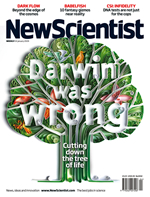Today is the 3rd annual Question Evolution Day, something that I only heard about this year, and what a great idea it is. Cowboy Bob Sorenson started it after Creation Ministries International (CMI) started their Question Evolution campaign. More can be found on his website http://www.piltdownsuperman.com/p/question-evolution-day.html
I thought it would be great to share a recent concession that Darwin was wrong in Britain’s secular science journal, the New Scientist.
As per Real Science Radio’s website and streaming talk show on this topic, the New Scientist article dated January 2009 stated that a UC Davis study,
“.compared 2000 genes that are common to humans, frogs, sea squirts, sea urchins, fruit flies and nematodes. In theory, [they] should have been able to use the gene sequences to construct an evolutionary tree showing the relationships between the six animals. [They] failed. The problem was that different genes told contradictory evolutionary stories. -New Scientist”
and further stated that the National Academy of Science reported,
“..ever more incongruous bits of DNA are turning up. Last year, for example, a team at the University of Texas… found a peculiar chunk of DNA in the genomes of eight animals [including] – the mouse, rat, …, little brown bat, … opossum, [a] lizard and [a] frog – but not in 25 others [where Darwin’s tree would have it], including [in] humans, elephants, chickens and fish.”
Infact, the entire Genome project is revealing predictions of the Creationist theory that show no evolution of DNA but rather similar and identical DNA in many creatures from sea sponges to humans as if a grand coder designed them and set their limits. This should not be the case if the Darwinian theory were true that molecules evolved over time from simple to more complex via advantageous mutations, adaptations, and natural selection.
The New Scientist article reveals that,
‘Conventionally, sea squirts – also known as tunicates – are lumped together with frogs, humans and other vertebrates in the phylum Chordata, but the genes were sending mixed signals. Some genes did indeed cluster within the chordates, but others indicated that tunicates should be placed with sea urchins, which aren’t chordates.
Biologist Michael Syvanen of the University of California said that, “Roughly 50 per cent of its genes have one evolutionary history and 50 per cent another… We’ve just annihilated the tree of life. It’s not a tree any more…”
But today the project [to reconstruct the tree] lies in tatters, torn to pieces by an onslaught of negative evidence. Many biologists now argue that the tree concept is obsolete and needs to be discarded. “We have no evidence at all that the tree of life is a reality,” says [an evolutionary biologist from Marie Curie University in Paris, Eric] Bapteste.
RNA, for example, might suggest that species A was more closely related to species B than species C, but a tree made from DNA would suggest the reverse.
And to make matters worse, protein sequencing might suggest yet a third evolutionary pathway, and then all of these were producing trees that contradicted the traditional pathways based on fossil evidence and anatomy.’
Creationists have shown and agreed that there is indeed adaptation within kinds that allow for great variations and a type of tree grows from each those kinds. ie. one dog ancestor on the Ark has branched out to become all the dogs on earth that we now see, but that these changes remain all within in their kind. There is no moving from a cat to a dog or a cow to a whale etc. thus it is not a single tree of molecules to man, but instead a crop of amazing kinds all appearing and adapting where need be as the creator coded them to do.
So a big Happy Birthday to Darwin, we hope that soon our scientific communities as a whole will overturn your mistaken theory. I am sure that your own view from eternity is one of frustration.
